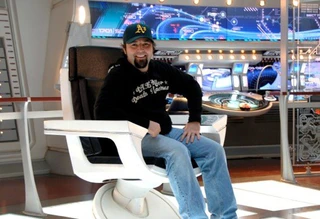
Clint Schultz worked as logo designer for Cloud Imperium Games.[1]
Works at CIG
Clint Schultz met Ryan Church on JJ Abrams 2009 version of Star Trek. Ryan and Clint have continued to cross paths on films like Super 8 & Into Darkness. They also worked on Brad Bird’sTomorrowland together. It was during the pitch work for Tomorrowland that Clint got a call from Chris Roberts based on Ryan Church recommendation. What started out as some part time logo work for the game turned into a full time position.[1]
The first logo he did was for RSI. From there he worked on the Star Citizen & Squadron 42 logo, which he's very happy with. Those two logos were the base for many of the marketing items developed for the Kickstarter campaign, such as ID cards, campaign posters, collectors editions, t-shirts, etc. Since he started full time, he developed a Cloud Imperium logo for the company. He also dworked on a number of logos such as Drake, Joker, Anvil, etc. He also spent some time working on new ship blueprints, Jump Point compositions, and additional technical material. he also worked on a set of logos for the various branches of the UEE. He loves the way the final 5 work both independently and as a group.[1]
Other Works
A lifelong interest in filmmaking led him to Los Angeles where he began his career as an art department assistant. One of those early opportunities led Clint into the Art Department of Tom Sanders and Dan Dorrance, who were in search of a graphic designer for their next feature. Clint’s use of traditional and digital design skills won him the job, and he became a member of the Art Directors Guild. In 2005 Dan Dorrance hired Clint to work with production designer Scott Chambliss on JJ Abrams first feature film Mission Impossible: 3. Since then he worked a many movies, including Godzilla: King of the Monsters, and four ADG nominees: Star Trek (2009) Cowboys & Aliens (2011) Star Trek Into Darkness (2013) Tomorrowland (2015). Additionally, Clint has worked on two features with Mr. Abrams company Bad Robot, Super 8 (2011) and more recently on Star Wars: Episode VII. He also worked on He also worked on Rebel Moon, Top Gun Maverick and ma many more. In 2017, Clint worked as production designer on The Hatred for Lionsgate. Since 2014, Clint has served on the Scenic, Title & Graphic Artists Council where he is the Vice Chairperson.[2][3]
He works on everything that is printed and physically shot on film such as props graphics, logos, vehicle skins, signs, wallpaper, etc...while for example in the case of Angels & Demons he worked on re-creating the Interior Pantheon, St. Peter’s Basilica, Sistine Chapel, Sala Regia, Chigi Chapel & Vatican Grottoes on sound stages at Sony Studios. In addition, they also built exterior locations for St. Peter’s Square and Piazza Navona on the parking lot of the Hollywood Park race track and casino.[1]
Early Life
He was born and raised in Amarillo, Texas and studied art at Randall High School prior to attending Texas Tech University. Upon graduation with a Bachelor Fine Arts degree, Clint was accepted to the graduate program at San Diego State University. He spent the next three years as a graduate instructor while completing his Master of Fine Arts degree. [3]
Quote
"Chris Roberts has some film credits of his own, so it’s been a fairly natural transition. The biggest difference is that we are not physically building sets, props, wardrobe, etc. Therefore, I spend a lot more time designing and a lot less time fabricating, budgeting and coordinating. Because of the futuristic theme of the game, my work on Star Trek is probably the most comparable. However, I’ve mostly done logos (for the game itself and in-fiction). On a film I would handle all the graphics in the environments and on the ships. Chris has a team of artists working on this project around the world, so my work in those areas has been limited." -Clint Schultz[4]
Trivia
- Star Citizen is his first experience with a game of any kind.[1]
- When he was hired to do Star Trek 2009, he was completely freaked out. He was not a Trekie, and only had a vague pop culture idea of that futuristic world. In the end, that worked in his favor to bring a fresh graphic look to an old classic.[1]
External Links
References
- ↑ 1.0 1.1 1.2 1.3 1.4 1.5 Engineering: Designing the UEE Logos. Transmission - Comm-Link. Retrieved 2013-03-19
- ↑ Clint Schultz, imdb
- ↑ 3.0 3.1 Studio Info, studio72inc.com
- ↑ Big Screen Design, Part 2: Working in Hollywood, howdesign.com, February 29, 2016, archived